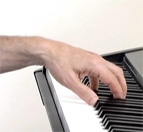About the Course (page 3 of 3)
The next three lessons, on theory once again, add to your growing understanding of how music works, and prepare you for what's to come. They cover whole steps and half steps, major scale structure (so you can build any chord), and how to transpose using a number system.
The tutorials called Piano Accompaniment Styles for 50 Great Songs help you to play a huge assortment of songs and genres. If chord inversions make chord changes smooth and easy, rhythm styles make them exciting.

The Ode to Joy tutorials are different from the other videos. They teach you to play a piano solo rather than to accompany. Since they're on a different "track" than the other lessons, feel free to try them whenever you like.
How to Play Big Leaps with Ease may appeal to more advanced players, though its mantra--"hurry up and wait"--is right on target for pianists at every level.
How to get the most out of the course.
The videos break down complex skills for you, demonstrating each baby step you need to take. (This is less true of the Rhythm Style lessons, which cover a lot of ground and move fast.) You'll know exactly what to practice and how to do it. But what's up to you is the quality control. If you try a particular step once and succeed, that's great—but it's only a start. Keep repeating each practice step until you can play it easily and consistently.
Practice made simple.
If you find yourself making mistakes or playing with tension, slow down. Much of the time, you'll need to practice very slowly indeed. Think slow motion.
As I show you in the tutorials, you can also practice each hand by itself, or focus on just one or two beats at a time. And you'll probably want to save the singing for later so you can concentrate entirely on learning the piano part.
For more on how to practice, see this.
Piano or keyboard?
Students often ask me what kind of instrument I recommend for practicing. You'll find some thoughts on that here on the site devoted to my private teaching.
Go to it!
And now, I invite you to dig in and start learning. Several lessons are free, so there's a lot you can do here without spending a cent.
If you haven't yet followed the links to it, my article called The Top Three Myths About Learning to Play the Piano explains the basic principles on which these lessons are based. It also has exercises, links to other resources, and practice strategies.
Enjoy!